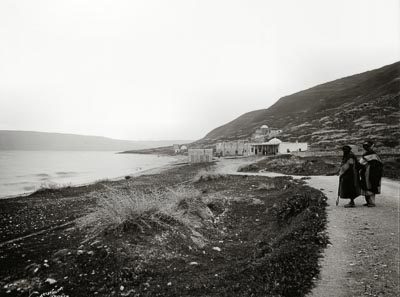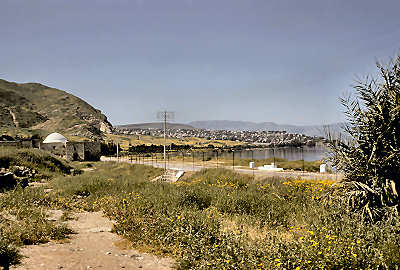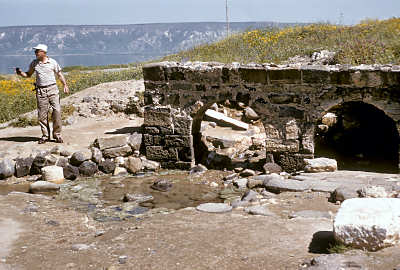
Hammath Tiberias
Hot Baths at Hammath Tiberias
The hot baths are frequented by Arabs, Syrians, and foreigners; and sometimes the crowds about them, and along the shore toward the city, present not only a lively, but, on account of the strange costumes of the people, a variegated scene. An old man named Haj Ali, whom we employed once as a hunter, an Algerine by birth, who had visited Mecca-a quiet, reserved, and dignified person-was the keeper of the bath, and from him we had "the freedom of the place." A serious drawback to comfort, however, was the fact that visitors bathe in the common basin, and the water is changed none too often. Some complaints are no doubt benefited by bathing here, and, with proper care, the springs might be made not only a comfort or a luxury, but a real blessing to the people of the land. The baths themselves, and all the buildings about them, were thoroughly repaired by Ibrahim Pasha in 1832-40; but to-day, although still in use, they are practically in ruins, "a fine example of the wise Turkish administration." (Source: Picturesque Palestine, vol. 2, p. 53.)
Tiberias View from Hammath Tiberias
Even after the city was built [by Herod Antipas] it remained in some respects distinct from that at the springs, and in other respects it was regarded as identical with it. This fact will be sufficiently illustrated by the following statement from the Jerusalem Talmud, where the discussion is with regard to the observance of the Sabbath, and it is said that the inhabitants of a large city can walk on the Sabbath to a small city, but the inhabitants of the small city are not allowed the corresponding privilege: for instance, "the inhabitants of Tiberias could walk on the Sabbath day through all Hammath, but the inhabitants of Hammath could go only as far as the pillar. At present, however, Hammath and Tiberias form only one city." (Source: Picturesque Palestine, vol. 2, pp. 50-51.)
Hammath Tiberias, Roman Bath Ruins
We then moved toward the south of Tiberias and found the hot baths, close to the shore. There are four springs here and three others a few paces further south. The temperature of the water is 144 degrees Fahrenheit; the taste is salt and bitter and the presence of sulphur very manifest. These baths are regarded as especially adapted to the cure of rheumatic complaints and are visited in the summer by people from all over the country. (Source: Earthly Footsteps of the Man of Galilee, p. 185.)
See Tiberias, History of Tiberias, Hammath Tiberias, Sea of Galilee, or Fishing and Fishermen
At BiblePlaces, see Sea of Galilee


